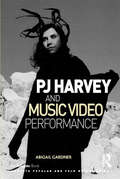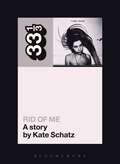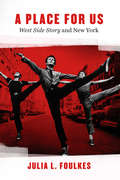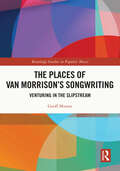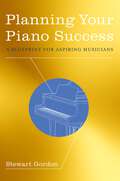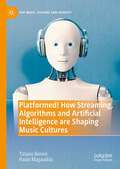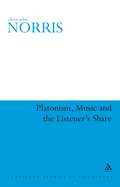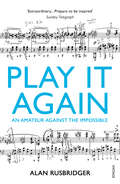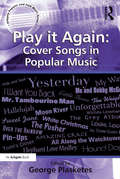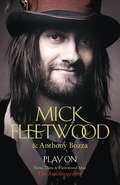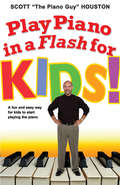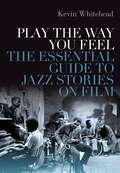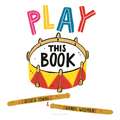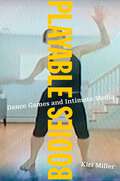- Table View
- List View
PJ Harvey and Music Video Performance (Ashgate Popular and Folk Music Series)
by Abigail GardnerPJ Harvey’s performances are premised on the core contention that she is somehow causing ’trouble’. Just how this trouble can be theorised within the context of the music video and what it means for a development of the ways we might conceptualise ’disruption’ and think about music video lies at the heart of this book. Abigail Gardner mixes feminist theory and critical models from film and video scholarship as a rich means of interrogating Harvey’s work and redefining her disruptive strategies. The book presents a rethinking of the masquerade that allies it to cultural memory, precipitated by Gardner’s claim that Harvey’s performances are conversations with the past, specifically with visualised memories of archetypes of femininity. Harvey’s masquerades emerge from her conversations and renegotiations with both national and transatlantic musical, visual and lyrical heritages. It is the first academic book to present analysis of Harvey’s music videos and opens up fresh avenues into exploring what is at stake in the video work of one of Britain’s premier singer-songwriters. It extends the discussion on music video to consider how to make sense of the rapidly developing digital environment in which it now sits. The interdisciplinary nature of the book should attract readers from a range of subject areas including popular music studies, cultural studies, media and communication studies, and gender studies.
PJ Harvey's Rid of Me: A Story (33 1/3)
by Kate SchatzRid of Me joins Music From Big Pink by John Niven and Meat is Murder by Joe Pernice as one of three fictional titles in the 33 1/3 Series, and tells the story of Kathleen and Mary, two women who find themselves alone in a house in the middle of the dark, forbidden forest that borders their depressed valley town. Amidst a dramatic natural setting, they negotiate their freedom, their pasts, their survival, and each other. Rid of Me is a story of escape and desire, violence and gender, landscape, family, and memory. It's a twisted fairy tale, a queer dystopia/utopia, and a lyrical exploration of kidnapping, dreams, murder, sex, revenge, and love. Kate Schatz's Rid of Me is at once a wholly original work of fiction and an innovative meditation on one writer's relationship to an album. The album in question is PJ Harvey's 1993 recording Rid of Me, a release noted again and again for its raw sound, dark lyrics, and unabashed presentation of female sexuality, desire, and rage. In her prologue, Schatz states that the book is "not about Rid of Me, but because of it" and the book's 14 chapters (one for each song on the album) use the lyrics, moods, images, and characters to create something entirely different, yet intimately connected to the music.
A Place for Us: “West Side Story” and New York
by Julia L. FoulkesFrom its Broadway debut to the Oscar-winning film to countless amateur productions, West Side Story is nothing less than an American touchstone—an updating of Shakespeare vividly realized in a rapidly changing postwar New York. That vision of postwar New York is at the heart of Julia L. Foulkes’s A Place for Us. A lifelong fan of the show, Foulkes became interested in its history when she made an unexpected discovery: scenes for the iconic film version were shot on the demolition site destined to become part of the Lincoln Center redevelopment area—a crowning jewel of postwar urban renewal. Foulkes interweaves the story of the creation of the musical and film with the remaking of the Upper West Side and the larger tale of New York’s postwar aspirations. Making unprecedented use of director and choreographer Jerome Robbins’s revelatory papers, she shows the crucial role played by the political commitments of Robbins and his fellow gay, Jewish collaborators, Leonard Bernstein and Arthur Laurents. Their determination to evoke life in New York as it was actually lived helped give West Side Story its unshakable sense of place even as it put forward a vision of a new, vigorous, determinedly multicultural American city. Beautifully written and full of surprises for even the most dedicated West Side Story fan, A Place for Us is a revelatory new exploration of an American classic.
A Place for Us: “West Side Story” and New York
by Julia L. FoulkesFrom its Broadway debut to the Oscar-winning film to countless amateur productions, West Side Story is nothing less than an American touchstone—an updating of Shakespeare vividly realized in a rapidly changing postwar New York. That vision of postwar New York is at the heart of Julia L. Foulkes’s A Place for Us. A lifelong fan of the show, Foulkes became interested in its history when she made an unexpected discovery: scenes for the iconic film version were shot on the demolition site destined to become part of the Lincoln Center redevelopment area—a crowning jewel of postwar urban renewal. Foulkes interweaves the story of the creation of the musical and film with the remaking of the Upper West Side and the larger tale of New York’s postwar aspirations. Making unprecedented use of director and choreographer Jerome Robbins’s revelatory papers, she shows the crucial role played by the political commitments of Robbins and his fellow gay, Jewish collaborators, Leonard Bernstein and Arthur Laurents. Their determination to evoke life in New York as it was actually lived helped give West Side Story its unshakable sense of place even as it put forward a vision of a new, vigorous, determinedly multicultural American city. Beautifully written and full of surprises for even the most dedicated West Side Story fan, A Place for Us is a revelatory new exploration of an American classic.
A Place for Us: “West Side Story” and New York
by Julia L. FoulkesFrom its Broadway debut to the Oscar-winning film to countless amateur productions, West Side Story is nothing less than an American touchstone—an updating of Shakespeare vividly realized in a rapidly changing postwar New York. That vision of postwar New York is at the heart of Julia L. Foulkes’s A Place for Us. A lifelong fan of the show, Foulkes became interested in its history when she made an unexpected discovery: scenes for the iconic film version were shot on the demolition site destined to become part of the Lincoln Center redevelopment area—a crowning jewel of postwar urban renewal. Foulkes interweaves the story of the creation of the musical and film with the remaking of the Upper West Side and the larger tale of New York’s postwar aspirations. Making unprecedented use of director and choreographer Jerome Robbins’s revelatory papers, she shows the crucial role played by the political commitments of Robbins and his fellow gay, Jewish collaborators, Leonard Bernstein and Arthur Laurents. Their determination to evoke life in New York as it was actually lived helped give West Side Story its unshakable sense of place even as it put forward a vision of a new, vigorous, determinedly multicultural American city. Beautifully written and full of surprises for even the most dedicated West Side Story fan, A Place for Us is a revelatory new exploration of an American classic.
A Place for Us: “West Side Story” and New York
by Julia L. FoulkesFrom its Broadway debut to the Oscar-winning film to countless amateur productions, West Side Story is nothing less than an American touchstone—an updating of Shakespeare vividly realized in a rapidly changing postwar New York. That vision of postwar New York is at the heart of Julia L. Foulkes’s A Place for Us. A lifelong fan of the show, Foulkes became interested in its history when she made an unexpected discovery: scenes for the iconic film version were shot on the demolition site destined to become part of the Lincoln Center redevelopment area—a crowning jewel of postwar urban renewal. Foulkes interweaves the story of the creation of the musical and film with the remaking of the Upper West Side and the larger tale of New York’s postwar aspirations. Making unprecedented use of director and choreographer Jerome Robbins’s revelatory papers, she shows the crucial role played by the political commitments of Robbins and his fellow gay, Jewish collaborators, Leonard Bernstein and Arthur Laurents. Their determination to evoke life in New York as it was actually lived helped give West Side Story its unshakable sense of place even as it put forward a vision of a new, vigorous, determinedly multicultural American city. Beautifully written and full of surprises for even the most dedicated West Side Story fan, A Place for Us is a revelatory new exploration of an American classic.
The Places of Van Morrison’s Songwriting: Venturing in the Slipstream (Routledge Studies in Popular Music)
by Geoff MunnsWhat can we learn about Van Morrison’s life and work as a songwriter through his songs? This book looks closely at the lyrics and music from a selection of his songs. Some are very well-known - ‘Brown Eyed Girl’, ‘Cleaning Windows’ and ‘The Healing Game’. Others are less familiar. Through these songs the book offers insights into some of the most important ideas that the songwriter has explored across his five-decade plus career, starting from the Them period and extending through his solo albums. These readings show how thinking about Morrison’s use of place provides a specific lens that contributes to a greater understanding of his art. The songs are organized into chapters that reflect many of the important places in Morrison’s work as he ventured professionally and imaginatively away from the places of his upbringing towards a wider musical world. These places are in city streetscapes and country landscapes – in home places of streets and ditches, in the enclosed spaces of rooms, in the expansive reaches of the natural world, in indeterminate and specific foreign lands. A picture emerges of the journey that Van Morrison details through his songs, one that sees him first wandering as a boy through his East Belfast haunts, and then venturing out to a wider world away from this local place.
The Places of Van Morrison’s Songwriting: Venturing in the Slipstream (Routledge Studies in Popular Music)
by Geoff MunnsWhat can we learn about Van Morrison’s life and work as a songwriter through his songs? This book looks closely at the lyrics and music from a selection of his songs. Some are very well-known - ‘Brown Eyed Girl’, ‘Cleaning Windows’ and ‘The Healing Game’. Others are less familiar. Through these songs the book offers insights into some of the most important ideas that the songwriter has explored across his five-decade plus career, starting from the Them period and extending through his solo albums. These readings show how thinking about Morrison’s use of place provides a specific lens that contributes to a greater understanding of his art. The songs are organized into chapters that reflect many of the important places in Morrison’s work as he ventured professionally and imaginatively away from the places of his upbringing towards a wider musical world. These places are in city streetscapes and country landscapes – in home places of streets and ditches, in the enclosed spaces of rooms, in the expansive reaches of the natural world, in indeterminate and specific foreign lands. A picture emerges of the journey that Van Morrison details through his songs, one that sees him first wandering as a boy through his East Belfast haunts, and then venturing out to a wider world away from this local place.
Plan of an Orchestra layout (UEB Contracted)
This is a labelled plan (seen from above) of a classical orchestra, showing where the various instrumentalists and the conductor are placed on the concert platform. There is a locator dot shown, which will be at the top left of the page when the image is the right way up. The conductor is in the bottom centre of the page; he is the performer who is nearest the audience and stands with his back to them, facing the rest of the players further up the page. The various areas occupied by the instruments are labelled. The stringed instruments occupy the bottom third of the page with the woodwind and brass instruments further up the page. The percussion instruments are at the top left of the page.
Plan of an Orchestra layout (UEB Uncontracted)
This is a labelled plan (seen from above) of a classical orchestra, showing where the various instrumentalists and the conductor are placed on the concert platform. There is a locator dot shown, which will be at the top left of the page when the image is the right way up. The conductor is in the bottom centre of the page; he is the performer who is nearest the audience and stands with his back to them, facing the rest of the players further up the page. The various areas occupied by the instruments are labelled. The stringed instruments occupy the bottom third of the page with the woodwind and brass instruments further up the page. The percussion instruments are at the top left of the page.
Planning Your Piano Success: A Blueprint for Aspiring Musicians
by Stewart GordonYoung pianists pursuing a professional career face a barrage of questions, choices, and challenges. In this book, experienced teacher and performer Stewart Gordon offers a new and practical way to approach them by helping readers to plan strategically and build a secure and successful career from the ground up. For decades, Gordon has guided young pianists through the details of how to prepare musically, navigate their college years, and forge a career that will provide a livelihood. In this guide to beginning that musical career, Gordon has assembled the wisdom of decades of teaching: a fundamental body of information emerging pianists will rely on as they work toward their goals. His advice, focused on both mental and practical work, will enhance both motivation and security. Carefully balancing aspiration with reality and inspiration with organization, Gordon creates a blueprint for transforming dreams into achievement, and illustrates his points with examples drawn from the lives of famous musicians. The book also addresses many practical matters, such as developing keyboard technique, acquiring reading and memorizing skills, building repertoire, and balancing the demands of being a musician with living a full life. This volume is a valuable resource for both young pianists and their parents.
Planning Your Piano Success: A Blueprint for Aspiring Musicians
by Stewart GordonYoung pianists pursuing a professional career face a barrage of questions, choices, and challenges. In this book, experienced teacher and performer Stewart Gordon offers a new and practical way to approach them by helping readers to plan strategically and build a secure and successful career from the ground up. For decades, Gordon has guided young pianists through the details of how to prepare musically, navigate their college years, and forge a career that will provide a livelihood. In this guide to beginning that musical career, Gordon has assembled the wisdom of decades of teaching: a fundamental body of information emerging pianists will rely on as they work toward their goals. His advice, focused on both mental and practical work, will enhance both motivation and security. Carefully balancing aspiration with reality and inspiration with organization, Gordon creates a blueprint for transforming dreams into achievement, and illustrates his points with examples drawn from the lives of famous musicians. The book also addresses many practical matters, such as developing keyboard technique, acquiring reading and memorizing skills, building repertoire, and balancing the demands of being a musician with living a full life. This volume is a valuable resource for both young pianists and their parents.
Platformed! How Streaming, Algorithms and Artificial Intelligence are Shaping Music Cultures (Pop Music, Culture and Identity)
by Tiziano Bonini Paolo MagauddaGrounded in more than a decade of field research, this book uses empirical examples, quantitative data, and qualitative interviews with young music consumers as well as music industry professionals to understand how the platforms behind music production, distribution and listening work in our digital society. Bringing together the perspectives from science and technology studies, media studies, and the political economy of digital platforms, the book outlines the process of mutual construction between music digital platforms and the cultural value of music in today’s society, and also reflects on the complicated relationship between the power of platforms and the agency of listeners.
Platonism, Music and the Listener's Share (Continuum Studies in Philosophy)
by Christopher NorrisWhat is a musical work? What are its identity-conditions and the standards (if any) that they set for a competent, intelligent, and musically perceptive act of performance or audition? Should the work-concept henceforth be dissolved as some New Musicologists would have it into the various, ever-changing socio-cultural or ideological contexts that make up its reception-history to date? Can music be thought of as possessing certain attributes, structural features, or intrinsically valuable qualities that are response-transcendent, i.e., that might always elude or surpass the best state of (current or future) informed opinion? These are some of the questions that Christopher Norris addresses by way of a sustained critical engagement with the New Musicology and other debates in recent philosophy of music. His book puts the case for a qualified Platonist approach that would respect the relative autonomy of musical works as objects of more or less adequate understanding, appreciation, and evaluative judgement. At the same time this approach would leave room for listeners share the phenomenology of musical experience in so far as those works necessarily depend for their repeated realisation from one performance or audition to the next upon certain subjectively salient modalities of human perceptual and cognitive response. Norris argues for a more philosophically and musically informed treatment of these issues that combines the best insights of the analytic and the continental traditions. Perhaps the most distinctive feature of Norris's book, true to this dual orientation, is its way of raising such issues through a constant appeal to the vivid actuality of music as a challenge to philosophic thought. This is a fascinating study of musical understanding from one of the worlds leading contemporary theorists.
Play It Again: An Amateur Against The Impossible
by Alan RusbridgerIn 2010, Alan Rusbridger, the editor of the Guardian, set himself an almost impossible task: to learn, in the space of a year, Chopin’s Ballade No. 1 – a piece that inspires dread in many professional pianists. His timing could have been better. The next twelve months were to witness the Arab Spring, the Japanese tsunami, the English riots, and the Guardian’s breaking of both WikiLeaks and the News of the World hacking scandal. In the midst of this he carved out twenty minutes’ practice a day – even if that meant practising in a Libyan hotel in the middle of a revolution as well as gaining insights and advice from an array of legendary pianists, theorists, historians and neuroscientists, and even occasionally from secretaries of state. But was he able to play the piece in time?
Play it Again: Cover Songs in Popular Music
by George PlasketesCovering”the musical practice of one artist recording or performing another composer's song”has always been an attribute of popular music. In 2009, the internet database Second Hand Songs estimated that there are 40,000 songs with at least one cover version. Some of the more common variations of this "appropriationist" method of musical quotation include traditional forms such as patriotic anthems, religious hymns such as Amazing Grace, Muzak's instrumental interpretations, Christmas classics, and children's songs. Novelty and comedy collections from parodists such as Weird Al Yankovic also align in the cover category, as does the "larcenous art" of sampling, and technological variations in dance remixes and mash-ups. Film and television soundtracks and advertisers increasingly rely on versions of familiar pop tunes to assist in marketing their narratives and products. The cover phenomenon in popular culture may be viewed as a postmodern manifestation in music as artists revisit, reinterpret and re-examine a significant cross section of musical styles, periods, genres, individual records, and other artists and their catalogues of works.The cover complex, with its multiple variations, issues, contexts, and re-contextualizations comprises an important and rich popular culture text. These re-recordings represent artifacts which embody artistic, social, cultural, historical, commercial, biographical, and novel meanings. Through homage, allusion, apprenticeship, and parody, among other modes, these diverse musical quotations express, preserve, and distribute popular culture, popular music and their intersecting historical narratives. Play it Again represents the first collection of critical perspectives on the many facets of cover songs in popular music.
Play it Again: Cover Songs in Popular Music
by George PlasketesCovering”the musical practice of one artist recording or performing another composer's song”has always been an attribute of popular music. In 2009, the internet database Second Hand Songs estimated that there are 40,000 songs with at least one cover version. Some of the more common variations of this "appropriationist" method of musical quotation include traditional forms such as patriotic anthems, religious hymns such as Amazing Grace, Muzak's instrumental interpretations, Christmas classics, and children's songs. Novelty and comedy collections from parodists such as Weird Al Yankovic also align in the cover category, as does the "larcenous art" of sampling, and technological variations in dance remixes and mash-ups. Film and television soundtracks and advertisers increasingly rely on versions of familiar pop tunes to assist in marketing their narratives and products. The cover phenomenon in popular culture may be viewed as a postmodern manifestation in music as artists revisit, reinterpret and re-examine a significant cross section of musical styles, periods, genres, individual records, and other artists and their catalogues of works.The cover complex, with its multiple variations, issues, contexts, and re-contextualizations comprises an important and rich popular culture text. These re-recordings represent artifacts which embody artistic, social, cultural, historical, commercial, biographical, and novel meanings. Through homage, allusion, apprenticeship, and parody, among other modes, these diverse musical quotations express, preserve, and distribute popular culture, popular music and their intersecting historical narratives. Play it Again represents the first collection of critical perspectives on the many facets of cover songs in popular music.
Play On: Now, Then and Fleetwood Mac
by Mick Fleetwood"After forty-six years of being on the road, now is the right time to look back in a way I've never done before: now and then. I'm looking forward to sharing it with you." Mick Fleetwood has been part of one of the world's most successful and adored bands for over four decades. Here he tells the full and candid story of that life, and what it is to be part of the ever evolving Fleetwood Mac. His all-access autobiography spans the career of one of classic rock's greatest drummers and band leaders, the co-founder of the deeply loved super group that bears his name. In this intimate portrait of a life lived in music, Fleetwood vividly recalls his upbringing in Cornwall, Egypt and Norway tapping along to whatever song was playing on the radio; his experiences as a musician in Sixties London; the early days of the band featuring Peter Green, and his close friendship with George Harrison and seemingly all of music royalty. Play On sheds new light on Fleetwood Mac's raucous history describing the highs and lows of being part of a band that he often single-handedly kept together. His love affair with Stevie Nicks, the creation of landmark albums like Rumours and Tusk, and the many incredible and outrageous moments of recording, touring, fighting, and loving with Fleetwood Mac: all are here. He describes his life's moments with the honesty and immediacy that his fans expect, taking us to the very heart of this multi layered life. It's been a tumultuous journey with the excesses of the band's huge success at times threatening to destroy what they strived so hard to create. But through it all it's been the drive to play on that has won out. Now, then, and always, it's Fleetwood Mac.
Play Piano in a Flash for Kids!: A Fun and Easy Way for Kids to Start Playing the Piano
by Scott HoustonGetting a child to play piano has never been easier!As seen on public television nationwide, Scott "The Piano Guy" Houston is the leading authority on fast and fun piano instruction. In Play Piano in a Flash for Kids! he simplifies his unique and effective method of learning to play piano, making it accessible to even the youngest want-to-be pianists. Highlighting popular, not classical, music, this book fosters and nourishes an early love for music by giving children the tools to play their favorite popular songs.Your child will be able to: Learn the basics of piano playing using a simple technique that pros use, which focuses on becoming a good player versus becoming a good notation reader Use easy-to-follow step-by-step illustrations that demonstrate each stage of learning Play popular music on the piano without having to learn how to read complicated sheet musicIt is a great book for kids who may have taken lessons previously but became frustrated by the long and complicated process. And all at a fraction of the cost of piano lessons!Both parents and children can have fun learning the piano or keyboard together, or children can work through the book on their own, with parents providing support only when needed. Play Piano in a Flash for Kids! is the perfect tool for parents or teachers to help their kids learn to play the piano quickly and easily.
Play Piano in a Flash for Kids!: A Fun and Easy Way for Kids to Start Playing the Piano
by Scott HoustonGetting a child to play piano has never been easier!As seen on public television nationwide, Scott "The Piano Guy" Houston is the leading authority on fast and fun piano instruction. In Play Piano in a Flash for Kids! he simplifies his unique and effective method of learning to play piano, making it accessible to even the youngest want-to-be pianists. Highlighting popular, not classical, music, this book fosters and nourishes an early love for music by giving children the tools to play their favorite popular songs.Your child will be able to:Learn the basics of piano playing using a simple technique that pros use, which focuses on becoming a good player versus becoming a good notation reader Use easy-to-follow step-by-step illustrations that demonstrate each stage of learning Play popular music on the piano without having to learn how to read complicated sheet musicIt is a great book for kids who may have taken lessons previously but became frustrated by the long and complicated process. And all at a fraction of the cost of piano lessons!Both parents and children can have fun learning the piano or keyboard together, or children can work through the book on their own, with parents providing support only when needed. Play Piano in a Flash for Kids! is the perfect tool for parents or teachers to help their kids learn to play the piano quickly and easily.
Play the Way You Feel: The Essential Guide to Jazz Stories on Film
by Kevin WhiteheadJazz stories have been entwined with cinema since the inception of jazz film genre in the 1920s, giving us origin tales and biopics, spectacles and low-budget quickies, comedies, musicals, and dramas, and stories of improvisers and composers at work. And the jazz film has seen a resurgence in recent years--from biopics like Miles Ahead and HBO's Bessie, to dramas Whiplash and La La Land. In Play the Way You Feel, author and jazz critic Kevin Whitehead offers a comprehensive guide to these films and other media from the perspective of the music itself. Spanning 93 years of film history, the book looks closely at movies, cartoons, and a few TV shows that tell jazz stories, from early talkies to modern times, with an eye to narrative conventions and common story points. Examining the ways historical films have painted a clear picture of the past or overtly distorted history, Play the Way You Feel serves up capsule discussions of sundry topics including Duke Ellington's social life at the Cotton Club, avant-garde musical practices in 1930s vaudeville, and Martin Scorsese's improvisatory method on the set of New York, New York. Throughout the book, Whitehead brings the same analytical bent and concise, witty language listeners know from his jazz segments on NPR's Fresh Air with Terry Gross. He investigates well-known songs, traces the development of the stock jazz film ending, and offers fresh, often revisionist takes on works by such directors as Howard Hawks, John Cassavetes, Shirley Clarke, Francis Ford Coppola, Clint Eastwood, Spike Lee, Robert Altman, Woody Allen and Damien Chazelle. In all, Play the Way You Feel is a feast for film-genre fanatics and movie-watching jazz enthusiasts.
Play the Way You Feel: The Essential Guide to Jazz Stories on Film
by Kevin WhiteheadJazz stories have been entwined with cinema since the inception of jazz film genre in the 1920s, giving us origin tales and biopics, spectacles and low-budget quickies, comedies, musicals, and dramas, and stories of improvisers and composers at work. And the jazz film has seen a resurgence in recent years--from biopics like Miles Ahead and HBO's Bessie, to dramas Whiplash and La La Land. In Play the Way You Feel, author and jazz critic Kevin Whitehead offers a comprehensive guide to these films and other media from the perspective of the music itself. Spanning 93 years of film history, the book looks closely at movies, cartoons, and a few TV shows that tell jazz stories, from early talkies to modern times, with an eye to narrative conventions and common story points. Examining the ways historical films have painted a clear picture of the past or overtly distorted history, Play the Way You Feel serves up capsule discussions of sundry topics including Duke Ellington's social life at the Cotton Club, avant-garde musical practices in 1930s vaudeville, and Martin Scorsese's improvisatory method on the set of New York, New York. Throughout the book, Whitehead brings the same analytical bent and concise, witty language listeners know from his jazz segments on NPR's Fresh Air with Terry Gross. He investigates well-known songs, traces the development of the stock jazz film ending, and offers fresh, often revisionist takes on works by such directors as Howard Hawks, John Cassavetes, Shirley Clarke, Francis Ford Coppola, Clint Eastwood, Spike Lee, Robert Altman, Woody Allen and Damien Chazelle. In all, Play the Way You Feel is a feast for film-genre fanatics and movie-watching jazz enthusiasts.
Play This Book
by Jessica Young Daniel WisemanFor fans of Press Here, this new interactive picture book line invites readers to touch and move and "play" with the book.To start our show we need a band--maybe you can lend a hand!There are lots of ways little hands can make music. Each page of this interactive book invites readers to strum the guitar, slide the trombone, crash the cymbals, and more--no instruments required! With a delightful rhyming text and engaging illustrations, this book is full of instruments waiting to share their sounds. The only thing this band needs is YOU! Just use your imagination, turn the pages, and Play This Book!Pair with Pet This Book, another title in this young picture book line that comes printed on heavy-duty card stock pages to stand up to all kinds of play!
Play This Book
by Jessica Young Daniel WisemanFor fans of Press Here, this new interactive picture book line invites readers to touch and move and "play" with the book.To start our show we need a band--maybe you can lend a hand!There are lots of ways little hands can make music. Each page of this interactive book invites readers to strum the guitar, slide the trombone, crash the cymbals, and more--no instruments required! With a delightful rhyming text and engaging illustrations, this book is full of instruments waiting to share their sounds. The only thing this band needs is YOU! Just use your imagination, turn the pages, and Play This Book!Pair with Pet This Book, another title in this young picture book line that comes printed on heavy-duty card stock pages to stand up to all kinds of play!
Playable Bodies: Dance Games and Intimate Media
by Kiri MillerWhat happens when machines teach humans to dance? Dance video games transform players' experiences of popular music, invite experimentation with gendered and racialized movement styles, and present new possibilities for teaching, learning, and archiving choreography. Drawing on five years of research with players, game designers, and choreographers for the Just Dance and Dance Central games, Playable Bodies situates dance games in a media ecology that includes the larger game industry, viral music videos, reality TV competitions, marketing campaigns, and emerging surveillance technologies. Author Kiri Miller tracks the circulation of dance gameplay and related body projects across media platforms to reveal how dance games function as intimate media, configuring new relationships among humans, interfaces, music and dance repertoires, and social media practices.
